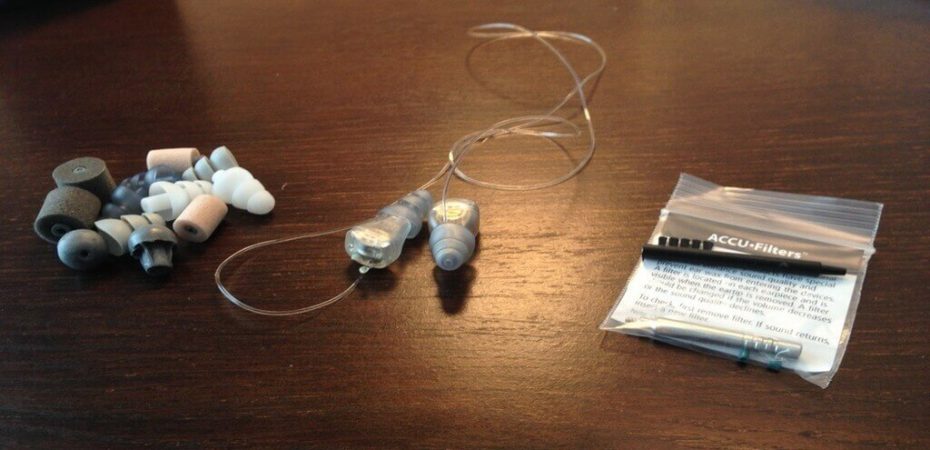Why do we exactly need earplugs? A commonly asked question with a simple answer – to protect your hearing capability from long term damage due to loud noises. Lucky, with sophisticated technology, we can now protect our hearing capabilities with active or electronic earplugs.
Why Buy Earplugs?
You would be surprised to know that your ears can be damaged by sounds you may encounter on a daily basis. Sound Volumes at or below 75dB are generally regarded as safe, and anything above 85dB can have a negative impact on your hearing.
The safe range of sounds are normal conversations which are about 60dB. However, something as common as the sound a lawnmower or vacuum cleaner makes can cause hearing loss if exposed for a long time.
Earplugs, both standard and filtered, serve as protection against loud sounds; they reduce the level of sound, allowing you to avoid hearing loss and extended exposure time. Unfortunately, earplugs don’t provide complete protection, but investing in a high-quality pair will minimize the harmful effects of excessive noise.
We have tried and tested several electronic earplugs to help you invest in the best earplug according to your needs. The following five electronic earplugs outshined in terms of both hearing protection and design quality.
Let’s give a closer look at our five best earplugs for concerts, shooting, and other environments with loud noises.
1. 3M PELTOR Tactical Earplug TEP-100, 1 Kit EA/Case
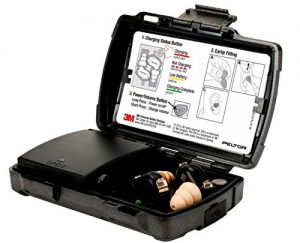
About Product
The 3M PELTOR Tactical Earplug is widely popular for their excellent hearing protection and improving auditory environmental awareness and communications.
The TEP-100 offers state-of-the-art, easy-to-use technology that helps amplify low sounds and efficiently block out loud noises. Although 3M PELTOR Tactical Earplug offers a low 23dB NR rating; however, according to our experience, this electronic earplug outperforms many earplugs with a higher NRR rating.
Pros
- Highly durable and comfortable ear tips
- Wind and water-resistant
- Small and lightweight design excellent for extended wear
- Easy to clean
Cons
- Pricy option
- Unimpressive wind protection
2. Etymotic GunsportPRO Earplugs
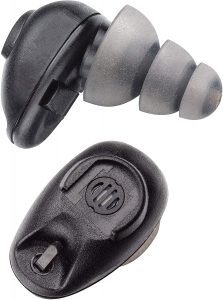
About Product
We highly recommend Etymotic GSP15 Gunsport PRO Earplugs for competitive and casual shooting sessions. These electronic earplugs are equipped with high-sensitivity microphones, high-definition balanced-armature sound drivers, and specially developed signal processing.
Although, Etymotic GunsportPRO Earplugs impress us with its excellent built quality and design. However, the low 15dB NR rating was a major con for us as there are many other electronic earplugs with a better NRR rating at this price point.
Pros
- Lightweight
- Excellent for long term wear
- Ear tips specifically for optimum comfort
Cons
- Pricy option
- High battery consumption
- No on/off button
3. Etymotic Research Music·PRO High-Fidelity Electronic Musicians Earplug
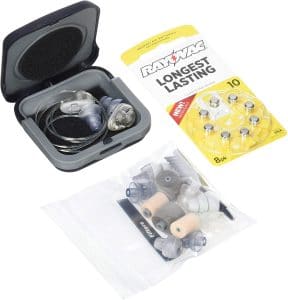
About Product
Etymotic is a widely trusted brand, especially popular for its remarkable quality headphones and earphones. Etymotic delivers the same premium quality with its Electronic Musicians Earplug.
The Etymotic Research Music·PRO High-Fidelity Electronic Musicians Earplug are an excellent option for music directors, music educators, entertainment industry staff, performers, security personnel, and other professionals that do not require a high NRR dB rating, but longer-lasting power and sufficient hearing protection.
Pros
- Impressive battery time
- Up to 15 dB – two amplification levels
- Comes with an assortment of ACCU-Fit ear tips
Cons
- Low dB levels
- High battery consumption
4. Westone DefendEar Digital Shooter Hearing Protection Ear Plug
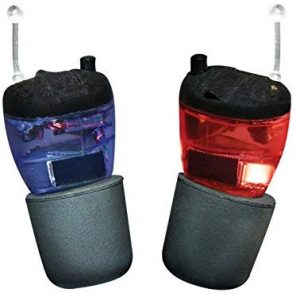
About Product
Also known as the “in-ear experts,” Westone DefendEar Digital Shooter Hearing Protection Ear Plug is amongst the most popular electronic earplugs with the highest NRR of 30dB. Westone DefendEar Ear Plugs offer optimum hearing protection that makes these earplugs suitable for a spectrum of applications.
Pros
- Excellent universal-fit design
- Easily cleanable, repairable, and upgradable
- Comfortable to wear
- Up to 86 dB – three amplification levels
Cons
- No power off button
- High battery consumption
5. SoundGear Instant Fit Recreational Electronic Hearing Protection (Pair)
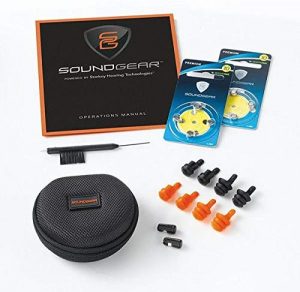
About Product
SoundGear Instant Fit Recreational Electronic Hearing Protection is equipped with the latest electronic hearing protection with an impressive Noise Reduction Rating (NRR) 25dB rating that can suppress noise at 93dB and 15dB of Amplification.
Soundgear Instant Fit also offers excellent customization options to ensure optimum comfort and hearing protection in the long term.
Pros
- High-definition sound enhancement
- Automatic noise suppression
- All-day, optimum comfort
Cons
- Small size that can easily get lost
Purpose of use
People commonly ask about the benefits of wearing earplugs and why should they invest in them. The most significant advantage of earplugs that is enough to convince you to consider investing in a pair of good quality electronic earplugs is the fact that over time, unprotect ears may suffer from hearing loss, especially if you are exposed to harmful loud noises on a daily bases.
Exposing your ears to sounds that are louder than 85 dB on a daily routine can drastically increase your chances of hearing the loss in the long term. Earplugs can effectively reduce the noise to a safer level.
HOW LOUD IS TOO LOUD?
Activities like shooting expose you to loud sounds so you can expect a few very loud bangs. However, it is crucial to know how loud is too loud for your ears to endure?
Is it ok not to have ear protection when engaging in activities that have loud sounds?
The simple answer is NO! It would be best to protect your ears because even a single gunshot sound can damage your ears. Nearly all calibers of guns emit a gunfire sound that is high enough in decibel (dB) level that can cause immediate harm to the ears.
The sound of close thunder and rock concerts is usually around 120 dB, which is enough for acute damage and can cause mild tinnitus and temporary hearing loss.
Compared to the over 140 decibels that a lot of calibers of firearms give, acute hearing loss can easily occur. You may experience long-lasting damage such as hearing loss if your ears are unprotected. A .22 rifle gunfire shot is around 145 dB, and a 170 dB sound from a 44 revolver can be harmful to ears even with a single shot because the sound is well over the 120 dB threshold.
Furthermore, repeated and significant exposure to sounds that aren’t as loud as gunfire (around 80 dB) can also lead to Chronic hearing loss. The lower threshold for damage is approximately 70 dB, so it is vital that you stay below that level when it comes to sound exposure in daily life.
WHAT CAN BE DONE TO PREVENT THE LOSS OF HEARING?
Wearing ear protection is the most effective approach to safeguard one’s hearing when participating in shooting sports. Having said that, you can protect your hearing in a variety of ways, including wearing ear protection and engaging in some of the other activities listed above.
Many shooters don’t realize that increasing the amount of ear protection they wear is one of the most effective safety measures. Both earplugs and earmuffs are capable of reducing noise by around 30 decibels. The combined reduction of 60 dB to 140 dB of gunfire reduces the total level below the threshold of 85 dB.
What exactly is the matter with the threshold of 85 decibels again? Keep in mind that hearing loss can result from prolonged or repeated exposure to sounds that are louder than 85 dB.
If you can limit the volume of the sound you’re exposed to below the threshold, you should be able to preserve your hearing.
DIFFERENT KINDS OF EAR PROTECTION
There are several distinct varieties of ear protection.
Knowing what essential gear, like ear protection, is currently on the market is a significant part of the formula for success in this endeavor.
Let’s go over your most commonly used choices for your protection so you can make an informed decision.
EAR PLUGS
Earplugs must be inserted into the ear canal to muffle and drown out ambient noise when shooting.
Earplugs made of disposable foam are popular among shooters. They are straightforward to use, inexpensive, and, most notably, for people who wear them frequently, they are simple to put on quickly.
A wide variety of improved non-disposable choices are also available, which might range from polymer insertables to high-tech digital earplugs.
The digital sound-activated compression (SAC) technology enables hunters to hear what is going on around them without obstruction, with the exception of sounds that are at dangerously high levels.
This remarkable feature perfectly ensures you can still hear the game while you are out hunting without impacting your hearing when you fire your weapon.
EARMUFFS
When used for shooting, earmuffs are designed to fit over the head and cover the entire ear. They can be taken off and put on with little to no effort at all.
The quality of sound attenuation achieved by several types of basic earmuffs is a function of their form and material.
Digital earmuffs offer some interesting technological characteristics that, in addition to lowering the volume of loud sounds using SAC, digitally enhance the quality of the sounds produced by the surrounding environment.
The capacity to hear while simultaneously shooting can be a game-changer for competitors and range instructors. Investing in high-tech ears is well worth the money when working with other shooters who need to be able to listen to and comprehend each other.
OTHER POSSIBILITIES
Not only can you protect your ears by wearing earplugs and earmuffs, but there are also a few additional options to consider when it comes to safeguarding your hearing.
When shooting, using a suppressor—which is an attachment that you can attach to your firearm—is a fantastic technique to keep the noise levels down.
They accomplish their purpose by rerouting the gas that has been compressed as a result of the ammunition being fired from the gun. Because of this redirection and the subsequent decrease in pressure, there was a discernible drop in the level of noise.
In addition to that, it lessens the muzzle flash and the recoil. This convenient attachment offers a number of advantages, but before you use it, you should verify the laws that apply in your state. Some regions of the United States do not allow for the muzzling of weapons.
TAKE A BREAK
When shooting, you should never discount the need to take breaks. Even with ear protection, repeated exposure over a long period of time can still cause harm.
Step away from the noise and rest your ears if you are suffering any of the usual signs of hearing impairment, such as ringing in the ears, tinnitus, hearing loss, or ear pain.
In the heat of the moment, it may be preferable for active-duty military personnel and law enforcement officers to hope for the best and disregard the symptoms they are experiencing.
However, a large number of people who shoot in this country have plenty of options that will preserve their hearing by stopping for the day should things get noisy.
Put away your weapon and try again another day if you notice any signs of hearing loss or damage after exposure to loud noises.
HOW TO SELECT THE MOST APPROPRIATE EAR PROTECTION
The NRR, or Noise Reduction Rating, is a standard applied to all sufficient ear protection.
The Occupational Safety and Health Administration (OSHA) has validated and given its stamp of approval to the straightforward method. The higher the number, the greater the noise attenuation the ear protection may provide.
Think about the capabilities of the ear protection you are considering before you even think about how the earmuff and earplug capabilities will function once you’ve integrated the two.
As an illustration, if you are shooting in a setting that does not require the capacity to hear what you are pursuing through the woods, then disposable foam earplugs are a fantastic addition to digital earmuffs. You can use these in conjunction with the earmuffs.
Or, if you have spent a lot of money on digital earplugs, it would be a poor option to skimp on the earmuffs that would block the fine noises that your earplugs were created for. This is because the earplugs will prevent you from hearing those sounds.
If all you need is inexpensive ear protection, you can choose from various options, including earmuffs made of throwaway foam or just the minimal essentials.
Double up on whatever you do, and you’ll be in good shape, no matter your pick.
IT IS NEVER TOO LATE FOR PROTECTING YOUR HEARING, SO DO IT NOW!
Everyone is familiar with that one shooter at the range who has been there for decades, has probably been on a few tours in various parts of the world, and has a wealth of fascinating anecdotes to share.
It’s the same person, and he’s the one with considerable hearing loss, so if you want to talk to him, you’d better raise your voice a bit. He’s reached the point where he can’t hear regular conversation levels anymore.
Once the damage has been done, nothing can typically be done to restore most people’s hearing. Even if there are techniques to increase understanding using the hearing that you do have, the fact is that you will have to learn to live with hearing loss.
You can do many different remedies to keep your hearing from getting worse, regardless of how long you’ve been shooting for. Have fun while you’re shooting, but don’t forget to wear ear protection and take other safety precautions to save your hearing while you still have the chance.
Conclusion
Fortunately, earplugs are available in several variations depending on the level of hearing protection that you require daily. We have recommended some of the best earplugs that are suitable for a range of noise protection situations.
However, before buying any of these electronic earplugs, make sure that you are well aware of the level of hearing protection, do you require according to your specific needs.
Read Also

